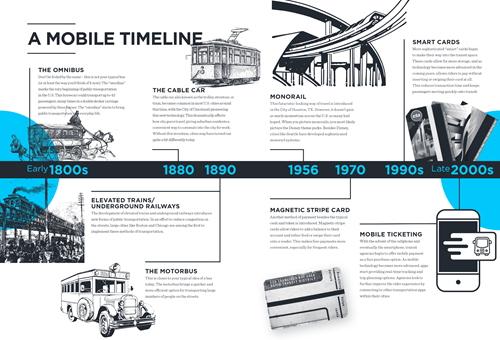
The transit industry has clearly made some major advancements; from the Omnibus to mobile ticketing, the history of transit has drastically impacted mobility. As we brace ourselves for the newest form of connectivity – mobile ticketing, get the latest insight, history of the transit industry, exclusive data, and industry perspective from a professional in our most recent e-book.
Early 1800s: Don’t be fooled by the name – this is not your typical bus (or at least the way you think of it now). The “omnibus” marks the very beginning of public transportation in the U.S. This horsecar could transport up to 42 passengers, many times in a double decker carriage powered by three horses. The “omnibus” starts to bring public transportation in everyday life.
The Cable Car (1880): The cable car, also known as the trolley, streetcar, or tram, becomes common in most U.S. cities around this time, with the City of Cincinnati pioneering this new technology. This dramatically affects how city goers travel, giving suburban residents a convenient way to commute into the city for work. Without this invention, cities may have turned out quite a bit different today.

Elevated Trains/Underground Railways (1890): The development of elevated trains and underground railways introduces new forms of public transportation. In an effort to reduce congestion on the street, large cities like Boston and Chicago are among the first to implement these methods of transportation.
The Motorbus (1890): This is closer to your typical idea of a bus today. The motorbus brings a quicker and more efficient option for transporting large numbers of people on the streets.
Monorail (1956): The futuristic-looking way of travel is introduced in the City of Houston, TX. However, it doesn’t gain as much momentum across the U.S. as many had hoped. When you picture monorails, you most likely picture the Disney theme parks. Besides Disney, cities like Seattle have developed sophisticated monorail systems.
Magnetic Strip Card (1970): Another method of payment besides the typical cash and token is introduced. Magnetic stripe cards allow riders to add a balance to their account and either feed or swipe their card onto a reader. This makes fare payments more convenient, especially frequent riders.
Smart Cards (1990s): More sophisticated “smart” cards begin to make their way into the transit space. These cards allow for more storage, and as technology becomes more advanced in the coming years, allows riders to pay without inserting or swiping their card at all. This reduces transaction time and keeps passengers moving quickly onto transit.
Mobile Ticketing (Late 2000s): With the advent of the cellphone and eventually the smartphone, transit agencies begin to offer mobile payment as a fare purchase option. As mobile technology becomes more advanced, apps start providing real-time tracking and trip planning options. Agencies look to further improve the rider experience by connecting to other transportation apps within their cities.
About Passport
Passport is North America’s leading mobile technology company specializing in enterprise business applications and payments for the public and private sector. Passport's product lines parking payments, transit payments, enforcement and permit management collectively serve to deliver dynamic tools for agencies to better connect with their communities. Its services have been adopted by over 20 of the top 50 cities in North America and over 2,000 locations including Chicago, Toronto, Boston, and Portland. Passport’s mission is to reduce operational complexity and deliver intelligent data to improve decision making for its clients.
Passport is backed by a highly respected group of investors, including Grotech Ventures, Relevance Capital, and MK Capital. For more information, please visit http://www.passportinc.com.




Comments
There are no comments yet for this item
Join the discussion